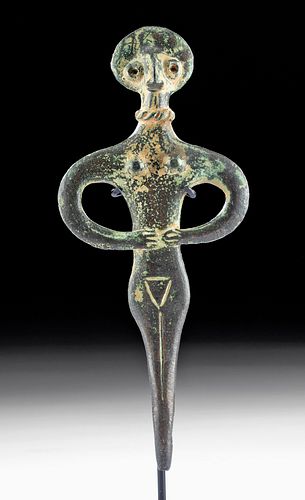Syrian Middle Bronze Age Goddess Figure, Art Loss Cert
Lot 69
About Seller
Artemis Gallery
686 S Taylor Ave, Ste 106
Louisville, CO 80027
United States
Selling antiquities, ancient and ethnographic art online since 1993, Artemis Gallery specializes in Classical Antiquities (Egyptian, Greek, Roman, Near Eastern), Asian, Pre-Columbian, African / Tribal / Oceanographic art. Our extensive inventory includes pottery, stone, metal, wood, glass and textil...Read more
Estimate:
$30,000 - $45,000
Absentee vs Live bid
Two ways to bid:
- Leave a max absentee bid and the platform will bid on your behalf up to your maximum bid during the live auction.
- Bid live during the auction and your bids will be submitted real-time to the auctioneer.
Bid Increments
| Price | Bid Increment |
|---|---|
| $0 | $25 |
| $300 | $50 |
| $1,000 | $100 |
| $2,000 | $250 |
| $5,000 | $500 |
| $10,000 | $1,000 |
| $20,000 | $2,500 |
| $50,000 | $5,000 |
| $100,000 | $10,000 |
| $200,000 | $20,000 |
About Auction
By Artemis Gallery
Feb 13, 2020
Set Reminder
2020-02-13 10:00:00
2020-02-13 10:00:00
America/New_York
Bidsquare
Bidsquare : Exceptional Antiquities, Asian, Ethnographic
https://www.bidsquare.com/auctions/artemis-gallery/exceptional-antiquities-asian-ethnographic-4848
An important one-day auction featuring museum-worthy examples of Egyptian, Greek, Roman, Etruscan, Near Eastern, Far East / Asian, Pre-Columbian, African / Tribal, Oceanic, Native American, Spanish Colonial, Russian, Fossils, Ancient Jewelry, Fine Art, so much more! Artemis Gallery info@artemisgallery.com
An important one-day auction featuring museum-worthy examples of Egyptian, Greek, Roman, Etruscan, Near Eastern, Far East / Asian, Pre-Columbian, African / Tribal, Oceanic, Native American, Spanish Colonial, Russian, Fossils, Ancient Jewelry, Fine Art, so much more! Artemis Gallery info@artemisgallery.com
- Lot Description
Near East, the Levant, Canaanite people, Middle Bronze Age IIA, ca. 1950 to 1750 BCE. A rare solid bronze cast goddess votive figure, flat cast. The female figure is extremely stylized and flat: the volumes are limited to a set of simple geometric shapes, overlapped one another without really forming a homogeneous composition. Abstraction and simplification are the characteristics that make this figure very modern. Her head is a disk, flat on the back but provided with a nose in the shape of a raptor’s beak, with a horizontal notch for the mouth; two buttons in relief indicate the eyes. The cylindrical neck is adorned with a thick necklace punctuated by diagonal incisions: the long elliptical arms (the hands are placed on the lower abdomen) encircle the triangular chest. The lower body is in the shape of a very elongated drop, with rounded thighs and a simple incision to mark the separation between the legs. Size: 2.8" W x 6.7" H (7.1 cm x 17 cm); 7.5" H (19 cm) on included custom stand.
Archaeologically, this image should be related to the large production of small bronzes originating in the Syrian (coastal region, Bekaa Valley, internal Syria) and Palestinian world of the 2nd millennium B.C., which represented both men and women with more or less accurate or stylized contours. Although their iconography is not always understandable, it is believed that these bronzes would represent deities or deceased sovereigns, have the role of worship images for small shrines or be simple ex-votos for a deity.
Our example can certainly be linked to one of the most ancient and famous groups of northern Syria, whose most signifi cant features are a fl at body with geometric shapes and a “bird’s beak” face. Despite the stylization and the lack of relief, the sexual connotation of the female bronzes belonging to this series is strongly accentuated.
The plastic breasts, the incised pubis, the hips and buttocks with their circular contour leave no doubt concerning the close relationship of this statuette with fertility and fecundity beliefs: even though many interpretive problems still remain, the stylistic and thematic comparison with the contemporary Paleo-Syrian glyptics suggests that fi gures of this group would be images of a deity, probably Astarte-Ishtar, the great Near Eastern goddess of love and war.
A very similar goddess figure sold for $242,500 at Christie's New York - June 8, 2012, Lot 43.
This piece is accompanied by a digital Art Loss Register certificate.
Provenance: private New York, USA collection, acquired on the German Art Market in 1990
All items legal to buy/sell under U.S. Statute covering cultural patrimony Code 2600, CHAPTER 14, and are guaranteed to be as described or your money back.
A Certificate of Authenticity will accompany all winning bids.
We ship worldwide and handle all shipping in-house for your convenience.
#152806Intact with surface wear commensurate with age, including some tiny scratches and nicks as well as pitting on the surface, notably on the chest. The patina has been cleaned from the eyes. Rich deposits and a great deep green and turquoise patina.Condition
- Shipping Info
-
All shipping is handled in-house for your convenience. Your invoice from Artemis Gallery will include shipping calculation instructions. If in doubt, please inquire BEFORE bidding for estimated shipping costs for individual items.
-
- Buyer's Premium



 EUR
EUR CAD
CAD AUD
AUD GBP
GBP MXN
MXN HKD
HKD CNY
CNY MYR
MYR SEK
SEK SGD
SGD CHF
CHF THB
THB















